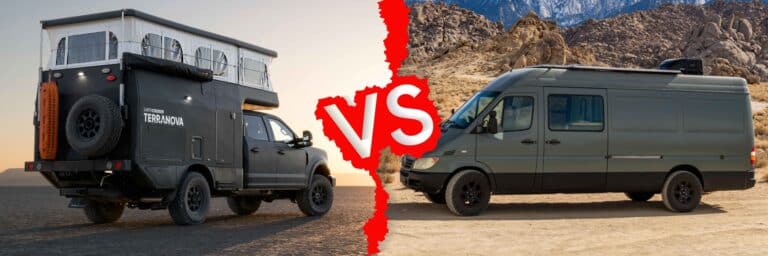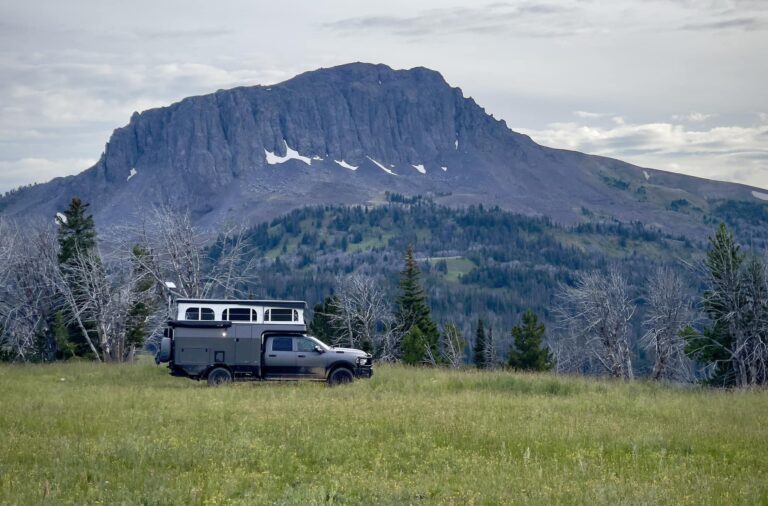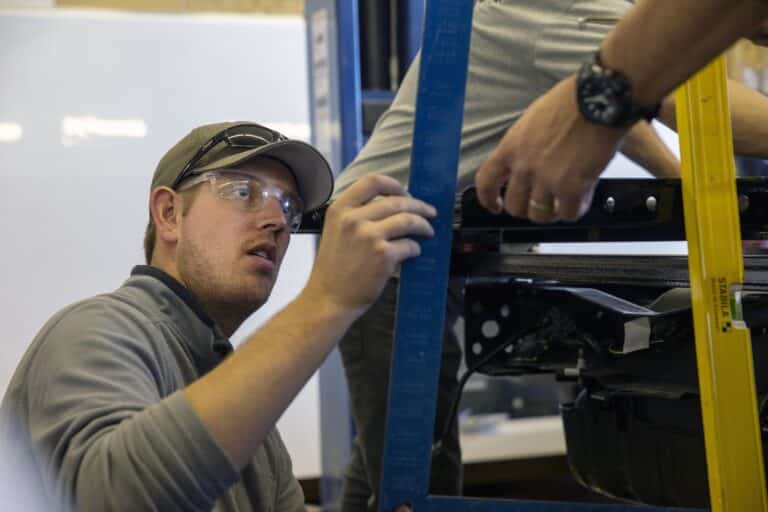When shopping for a new overland vehicle, there are many factors to consider and an ever-growing array of available vehicles. Some of the most common vehicles are adventure vans, typically all-wheel drive models either converted to an overland vehicle at a specialty shop, built out DIY style, or purchased as a complete vehicle. Here we look at these vans and consider why a Terranova might be a better fit for those looking for their next overlanding vehicle:

1. Build Quality
As you start to look at and compare vehicles, one of the most important questions you can consider is how you will use it. Will you be driving primarily on or off-road? For two days at a time or two months? Will you live in it full time or take it out on the occasional weekend or mini adventure? Whatever conclusion you reach, it’s essential to consider if the vehicle you’re looking into will meet that level of use. Building quality and materials are among the most significant factors that will answer that question.
A vehicle designed to be used frequently for longer trips and over rougher roads will be built of lightweight yet durable materials and easy to clean and repair or replace. Wood, which is used in many DIY and built-out adventure vans, looks beautiful and can be easy to replace, but it’s relatively heavy, is prone to changing shape when damp, and can get dented or break fairly easily. Fiberglass is the material of choice for many vehicles that need to remain strong, light and withstand the elements, such as boats, it is also relatively supple making it an excellent choice for components that need to retain their shape. Carbon fiber is even lighter but not very abrasion-resistant and can break or shatter when compressed or stressed.
The EarthCruiser Terranova comes with a 3-year warranty that covers its house fiberglass superstructure. Only the best and most rigorously tested materials and components go into a Terranova. Many of the Terranova’s materials and building techniques come borrowed from the marine industry, where water and weatherproofing, ease of cleaning, and durable strength are essential qualities. One of the ways you’ll immediately notice this quality is in how quiet the vehicle is, even over rough roads. The construction materials, design, and hardware selection mean nothing rattles, squeaks, or bangs, even on corrugated or rocky terrain. Not only does this mean it’s a quieter travel environment, but you know nothing is slowly vibrating loose or shifting and causing failure.
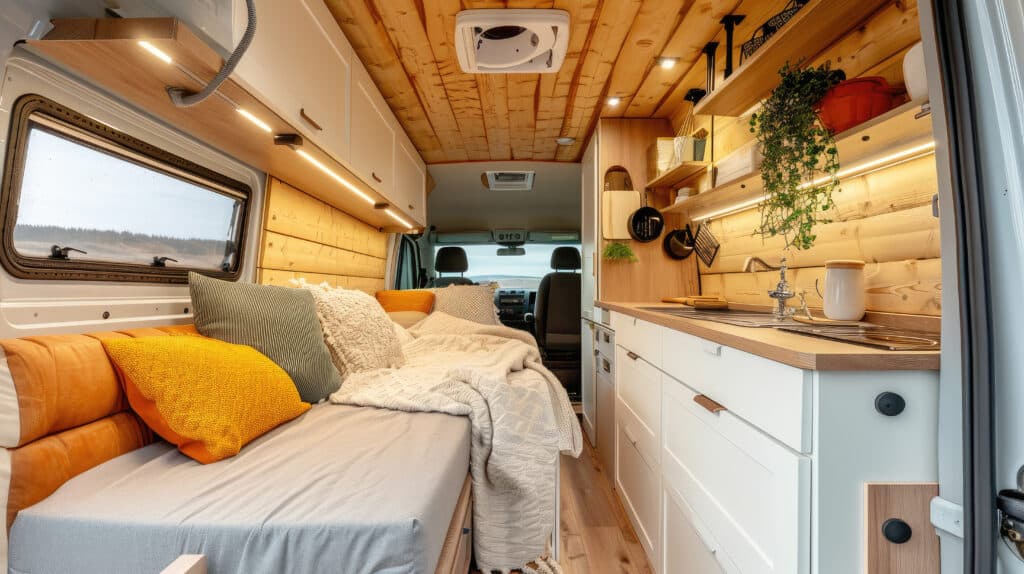
2. Interior Layout and Design
Storage
The interior height of adventure vans means there’s room on the interior walls to mount cabinets above work surfaces like countertops. While having cabinets high up on the interior walls of your vehicle is a great use of space, it comes at the price of increasing the height of the vehicle’s center of gravity, which diminishes balance, maneuverability, and performance. It also means that every time your vehicle tilts, the items in those cabinets are thrown very far off the vehicle’s center line.
Many vans don’t offer storage compartments that are accessible from the exterior of the vehicle. The advantage of exterior storage is that items you may need during vehicle recovery, such as straps and shackles, are quick and easy to access. It’s also a great spot to store gear you’ll use outside, such as camp chairs and outdoor cooking gear. It also keeps this kind of gear, which tends to get wet, muddy, and dirty, away from the clean interior of your home.
Walk through vs passthrough
An advantage of most vans is the ease of moving between the driving area and the living space. This opens up the spacious feel of the living area and makes it a breeze to pop between driving and camping. The EarthCruiser Terranova has a passthrough instead, which allows access via an easily crawlable opening.
Having access between the chassis and living space is important for safety. Imagine having to leave a remote campsite in the middle of the night due to an emergency such as a storm, aggressive wildlife or intruder. Being able to move from the sleeping area to the driving area without exiting the vehicle can save precious time and keep you protected in such situations. It’s also simply convenient for those times you want to grab an item, such as a cold beverage, without leaving your vehicle and helps you to monitor the interior of your living space for loose objects.
Sleeping Arrangement
Adventure Vans come in a wide array of floorplans with differing sleeping arrangements. Some put the bed above large storage areas, which is a good use of space but limits the ability to sit up in bed and use that area for reading or working. Others require that the sleeping area is converted from a dining space or storage each night. This might not be a bid deal to someone using their vehicle for short trips, but the act of having to make up and take down their sleeping area every night can feel like a chore after more than a couple of nights in a row.
Another thing to take into consideration is the direction of the bed, particularly if you’ll be sharing your space with another person. The Terranova bed offers plenty of space to sit upright when the pop-up roof is expanded, does not need to be converted to sleep in and is oriented in a north/south position. This means no one has to crawl over their partner should nature call in the middle of the night.
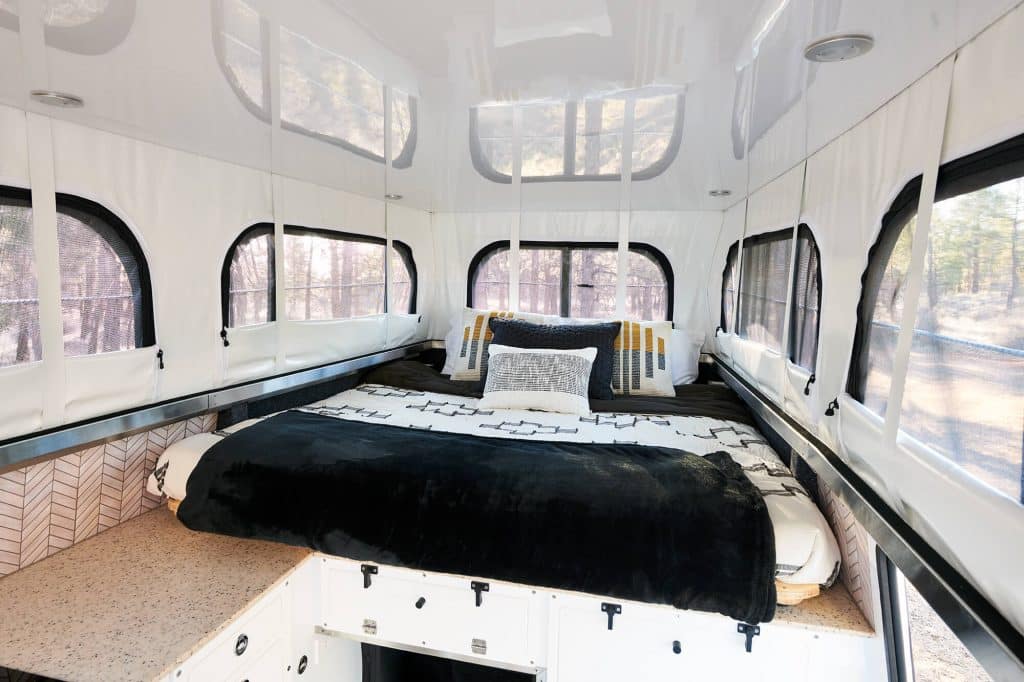
3. Off-Road and Driving Capabilities
Body on Frame Construction
Most often, adventure vans are built on a unibody chassis. We go into further detail on why we prefer body-on-frame construction here, but in short, body-on-frame chassis are stronger and more durable. A body-on-frame chassis, such as what the Terranova is built on, can generally take more abuse and outlive its unibody counterparts. They can better tolerate torque and flexing, which means better handling off-road and less stress on the vehicle’s housing and living space components.
Horsepower
While horsepower isn’t everything when it comes to vehicle selection, it certainly can be an important factor depending on how you plan to use your vehicle. An adventure vehicle that is overweight with lower horsepower will struggle up hills, even on paved roads and be more prone to getting stuck in mud, snow, and dirt.
Most Mercedes sprinter-based vans produce around 188hp from a diesel engine. Vans build on a Ford Transit gas engine come in at around 310hp. The Terranova is available on Ford and RAM chassis, either diesel or gas with horsepower ranging from 335-410.
Ground Clearance
One of the biggest reasons you may prefer a camper truck like the Terranova to an off-road van is ground clearance. The extra couple inches a truck-based vehicle offers over a van, even vans with upgraded wheels and suspensions, can mean the difference between being able to explore backroads, snowy roads, and sandy beaches, getting you further away from the crowds and at less of a risk of creating a recovery situation. The larger tires of the Terranova also help to increase traction.
Passenger Safety
If your intended travel group size is over 2, you must carefully consider where additional people will be seated while driving. Will each passenger get an approved lap and shoulder belt? Will they be traveling facing the side of the vehicle, which many find uncomfortable for long journeys? Are the seats designed for safety and comfort, or are they an afterthought? Are they appropriately sized for your party, including small children? The Terranova seats four persons comfortably in actual car seats with seatbelts with lap and shoulder belts, and it’s possible to add car seats for small children safely.
4. Vehicle Size
Footprint
The overall footprint of any overlanding vehicle determines what kind of roads you can navigate, how you can ship your vehicle, and where you can park it. Adventure vans are typically slightly shorter than the Terranova but wider and taller.
The Terranova’s popup roof means it is shorter and more aerodynamic when driving, creating less wind drag and noise and allowing you to access everyday spaces like drive-thru windows and parking garages. And, when the roof is up, the interior space is taller than most vans, offering 81” of headroom compared to the typical van height of just 75”.
The Terranova comes in 3-4” narrower than standard adventure vans, making it easier to park and navigate through narrow backroads and busy streets. That extra couple of inches means many adventure vans can’t fit in standard shipping containers. This is important for those planning on taking their vehicles overseas, as being able to ship in a container means you can better protect your vehicle from the elements and theft. Additionally, it’s currently challenging to ship any vehicle with a lithium battery outside of a container due to recent fires onboard roll-on roll-off vessels.
Living space
One of the most important things to many people looking to do longer trips or live in their adventure vehicle is the amount of living space it offers. The living space area inside most converted vans runs around 70-80 square feet.
The house of the Terranova offers about 90 square feet of living space, with approximately 28 square feet in the bed area and 62 square feet in the kitchen/dining/living space.
| Dimensions and Capabilities | Terranova | Adventure Van |
| Width | 82″ | 85″ |
| Length | 288″ | 240″ |
| Exterior Height | 100″ | 120″ |
| Interior Headroom | 81″ | 75″ |
| Fuel Capacity | 33-48 gal | 25 gal |
| Horsepower | 335-410 hp | 188 hp |
| Tow Capacity | 15,000-17,500 lbs | 5,000 lbs |
| Fresh Water Capacity | 36 gal | 21 gal |
| Ground Clearance | 9″ | 8″ |
| Seatbelts and Car Seats | 5 | 2 |
| Solar Watts | 324W | 100-200W |
| House Battery | 460wh | 200-300wh |
5. Towing Capabilities
If your adventure lifestyle involves lots of toys, such as boats, motorcycles, snowmachines and horses, it will be important to consider tow capacity in your decision making.
The tow capacity of most adventure vans, built on Mercedes Sprinter or Ford Transit chassis will be around 5,000lbs, enough for a light trailer such as for bicycles. Standard toy haulers weigh in at an average of 7,500lbs before adding in the weight of an ATV or snowmobile.
The Terranova is capable of towing between 15,310-17,500lbs, depending on your choice of chassis. This is enough for toy haulers, boats and even a horse trailer.
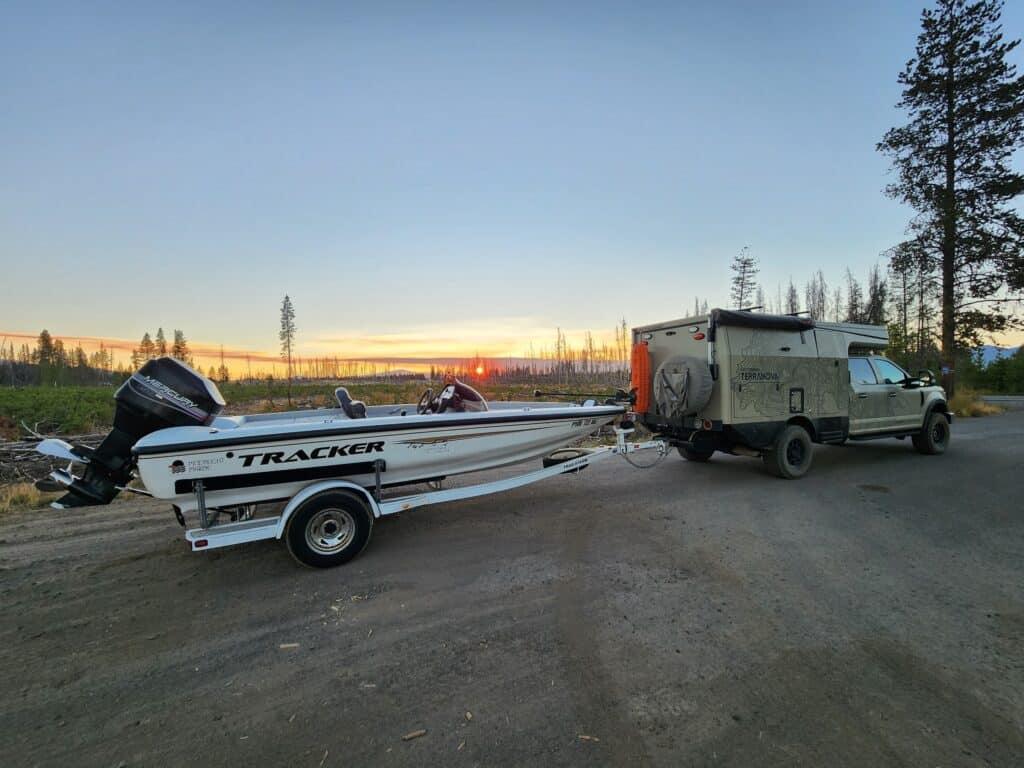
6. Ability to Stay Off-Grid
Consider the length and type of trips you’ll want to take in your new overland vehicle. If most of your travel will be between developed campgrounds, you probably don’t need more than a couple of days’ worth of potable water onboard, you might not need a toilet or shower in your vehicle, and having a limited amount of battery power for your appliances might be acceptable. If, however, you hope to spend considerable time dispersed camping, or boondocking, or hope to avoid frequent trips to gas stations to top up on fuel, water and supplies, you may find a typical van limiting.
Water
Adventure vans typically have 20-gallon water tanks, and few include a filtration system. The typical RV user goes through around 6-10 gallons of fresh water daily, meaning a 20-gallon tank will last most users two or three days. Few vans offer filtration or purification systems, meaning you’ll need to be sure the water you’re filling up with is potable.
The Terranova has two freshwater tanks totaling 56 gallons. It also includes a filtration and purification system, meaning you can fill it up virtually anywhere and enjoy 5-9 days between refills.
Restroom and Shower
Adventure vans don’t always have toilets, but when they do, they’re often cassette or portable verities. This means you’ll need to find an appropriate dumping station to empty them, typically every three to four days.
The Terranova comes standard with a composting toilet. Composting toilets reduce your water consumption, eliminate the need for a black water tank, and reduce the frequency of emptying. Typically, users empty their solid tanks after around three weeks of consistent use. Our owners report that the composting toilets in our vehicle produce less odor and are far easier to maintain than cassette or portable versions.
Power and Fuel
The Terranova come standard with 324 watts of solar power, 460Ah lithium house battery and a 3000W inverter. Most Adventure Vans top out at 90-200 watts of solar power. Not all vans come standard with lithium batteries and most offer around 200Ah. How much power you need all depends on what appliances you’d like to use and for how long. For weekend trips a smaller battery and fewer solar panels may be sufficient, for multi-day adventures, particularly if you hope to cook your meals inside your vehicle, or use devices such as Starlink, you may find you want a more robust power system.
Other ways in which the Terranova helps its owners to stay off-the-grid for extended periods of time include larger fuel capacities, and the use of a single fuel source, thus eliminating the need for trips to the gas station for frequent fueling and the use of propane for cooking and heating.
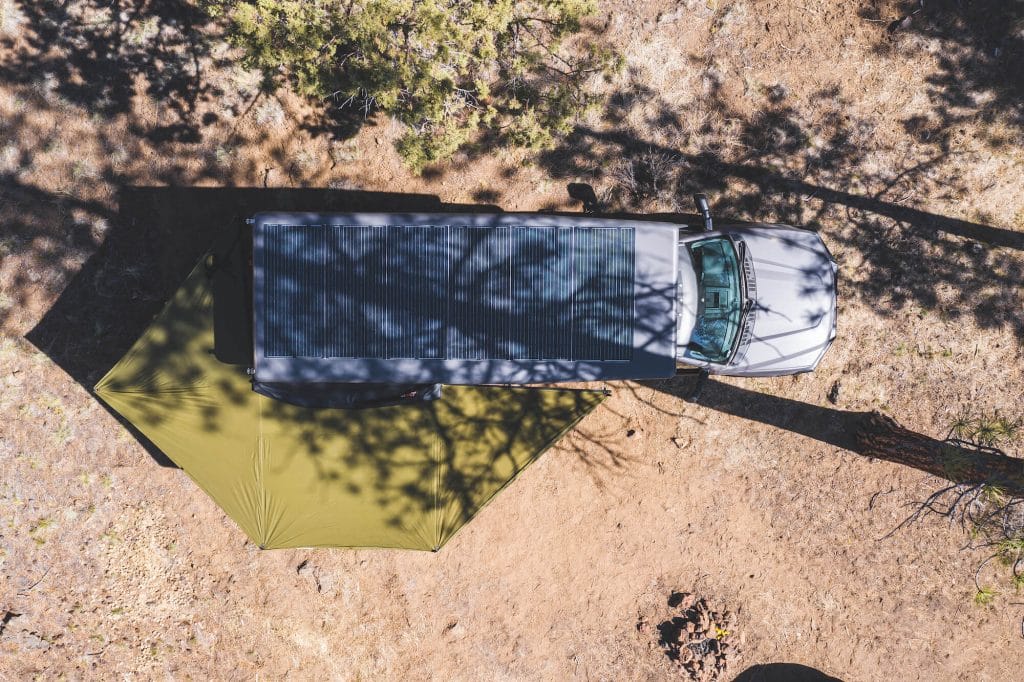
Does a van feel like the best fit for you? Stay tuned as we continue development of the EarthCruiser Evado. The Evado will be built on Mercedes Sprinter and Ford Transit chassis and feature the same durability and design standards as the EarthCruiser EXP, FX and Terranova. If the Terranova would be your choice of vehicles contact our sales team to find out more and set up a test drive.






